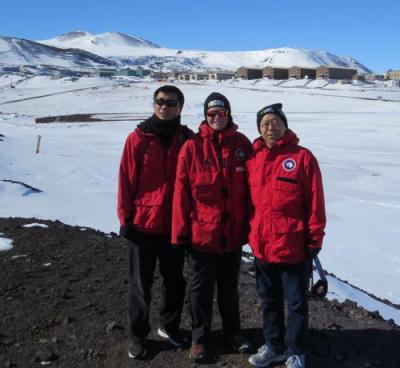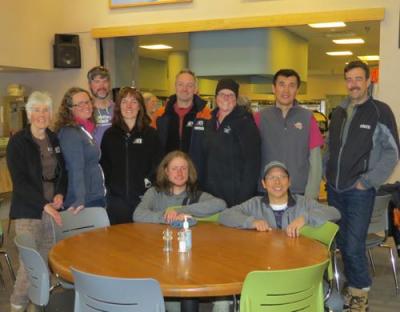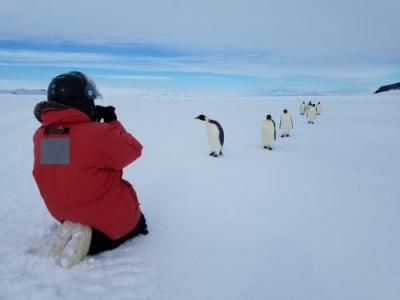The Experience of a Lifetime
A little over 1 year ago, I received a phone call that changed my life. I had been selected to become a PolarTREC Teacher and would be heading to Antarctica in the fall of 2017. Words cannot adequately describe the joy and excitement I had in that moment. I knew I was headed for an ultimate experience, one that would be life-changing, memorable beyond anything I had ever encountered and inspiring, not only for myself, but for my students as well.
I am a High School AP Science teacher. I have been teaching for over 20 years and I still eagerly look forward to each new school year, the school supplies hitting the shelves in mid-summer and learning about each of my new students. I love what I do and love to share my experiences with my students. Authentic teaching is always best when it is truly passionate and comes from the heart. I have found in my years in the profession that students do better when I am passionate and full of life in the classroom. Every experience I take on, helps me to be the best teacher for my students and provides me the opportunity to excite passion in my students. 
The PolarTREC experience is like no other program I have invested in. It is one that has already changed my teaching and likely will continue to do so long after my time on the ice. The skills I have gained and the manner in which I saw science being executed will find their way into my everyday teaching. Connections to scientists and the sheer volume of science I learned will also benefit my students through stronger engagement, the ability to connect them with outside researchers and future job possibilities.
The logistics of this experience took time to become clear and there was much training involved in ensuring the experience would be successful. PolarTREC has an amazing staff and has developed a program to initiate newcomers and to prepare them for their time in the field. The time spent in training in Alaska was invaluable to my expedition. I was also able to meet with my team prior in June prior to our departure in October. This was also highly valuable and provided a great deal of insight into what the research and experience would entail. My team, researchers from the University of Texas at San Antonio, graciously accepted me as one of their own and helped me to understand the science they were doing and allowed me to take part, side-by-side, in the work they were doing.
The Science of Ice
In Antarctica, my team consisted of Dr. Hongjie Xie and Dr. Yongli Gao. They were working with a principal investigator back in Texas, Dr. Stephen Ackley. We also worked along side the New Zealand team under the direction of Dr. Pat Langhorne and Dr. Greg Leonard, 
Data that was collected included the thickness of the sea ice, the snow depth that sits on top of the ice, free board, salinity, structure and temperature of the ice throughout the ice core and various isotope measurements. Our group of three worked in the field to drill ice cores and collect measurements from those core sites around the Ross Sea. We later made thin sections of the ice cores to determine structure at 10 cm depths along the core, melted sections and determined salinity, pH and later, isotope analysis.
The measurements taken by our team and others, will perhaps help to guide future policy in regards to changes in the ice in Antarctica. Establishment of a complete data set of seasonal changes of the ice in the Ross Sea, a unique place in terms of climate change, is necessary to better inform scientists and the world at large.
Take-Aways
There is so much science going on in Antarctica. I had no idea the scope, diversity, or magnitude of what was happening in the southern end of our globe. As a science teacher, you inevitably understand that there are scientists in Antarctica who are involved in understanding polar ecosystems, geology and weather. Maybe you think there are a few scientists that go every year. I discovered there were 100’s of scientists (just from the US) in every discipline imaginable and some I had no idea even existed. I also learned that science really is something that is not set in stone. The best laid plans seldom work the way you think they may in the field. There is much “science-ing” done on the science. Back-up plans are needed for back-up plans and sometimes, no amount of back-up can prepare you for what you face. Being flexible, creative and patient are sometimes your best friends. This was another great learning aspect of the experience. 
I was unaware of the potential for jobs for young people and the size and age of science teams. It was eye opening, and pleasantly so. I learned that 60% of the population in Antarctica are those in lines of work in support of science, but not actually doing science. There were some 53 fire fighters at McMurdo. This was an amazing discovery and one that I have been touting to every one I come in contact with. I, like many students in my classroom, had the impression, prior to being in Antarctica, that you really had to be either exceedingly wealthy or a decorated scientist to ever journey to Antarctica. This couldn’t be further from the truth. High Schools are stepping up the career education as college prices rise and college debt soars. My time in Antarctica was really quite ‘timely’. I feel very fortunate to be able to offer a new possibility to students for their future.
I went to Antarctica thinking I would learn how polar science was conducted and what it is like to be a scientist working on the harshest continent on the globe. I got so much more than that from this experience. The science was amazing, from that of my own team to the science of penguins and seals, to fish and diatoms, to robots and Europa. I was able to meet an award winning writer, two artists, the crew from the BBC filming about the extremes of Antarctica, extreme divers, a grammy winner, countless NSF representatives and administrators and a plethora of individuals who are helping to advance the science of Antarctica. All of these people had a story and it was truly endearing to learn about them and why they were in this most magical of places. 
I have left Antarctica, but my heart remains on its ice. I have made life-long friends. Dr. Xie and Dr. Gao were fabulous to work with. In truth, I was very nervous about spending a month+ in Antarctica with 2 men I didn’t know very well and who initially I had difficulty in communicating with due to our language/accent barrier. Over the weeks however, thanks in large part, to the hikes we took together as a group and the willingness of the those two to take me on as a member of the their team, we really became a functioning and cohesive unit. I hope that our relationship will be one that will endure a lifetime.
Bringing it Back
I am not sure a single day has passed since my return that I have not referenced in my teaching something I learned, participated in, saw or otherwise experienced on this journey. It could literally be something as mundane as reviewing exam questions and pointing out a graph the students had to construct that included standard error bars. So many graphs I encountered on the walls in the Crary Lab had S.E. bars and I have pictures to show my students that it really is what is being done in “true” science. Of course, this then leads into discussions about what those graphs are showing and what type of work is being done in Antarctica. I am making connections where I didn’t know I could. Students are gaining and seeing the importance of what I am teaching. It holds a new validity that wasn’t there before. 
My plans for the future in my classroom are to incorporate polar science into a variety of lessons in both of my subjects. AP Biology will coincide nicely with the information I gained about seals, penguins, fish anti-freeze proteins, diatoms and graphs utilizing standard error. AP Environmental Science will be injected with climate aspects, salinity and ice, plate tectonics, mapping of the sea floor using lidar, ocean currents, wind currents and global movement of toxins via air and water. All of my students will continue to hear about possible careers and jobs available in Antarctica. Further I will infuse what I now know about how science is done in the field into my lab and inquiry into the classroom. The problem solving and critical thinking skills needed in the field will now be a part of my labs and activities in the classroom.
Sharing the Experience
I have already been busy speaking about my experience to Antarctica. I had an engagement in my hometown of Potosi, WI to speak to all grades, K-12. I gave three presentations the day I visited and each presentation was geared to the appropriate level. I spoke at a school board meeting and will speak at a faculty meeting coming up this spring. I will also be spreading the word at WSST (WI Society of Science Teachers) in the spring of 2019 and am hoping to present at the WAEE (WI Association of Environmental Educators) this coming fall. My daughter’s girl scout troop will be hosting me as well this spring and I have been in contact with my alma mater, Concordia University in both their education programs and natural sciences. I am looking to present this summer at my local library and perhaps at an area senior center. In June, I will be reading for the AP Environmental Science Exam and will share the PolarTREC experience with anyone willing to listen!
This journey of a lifetime is hard to put into words. I can share pictures, science, experiences I had while on the ice and even talk about the amazing scientists I worked with, but at the end of the day, I have difficulty truly describing the immense affect this journey has had on my life. I am often asked what the best part of the experience was. I cannot for the life of me pin down a single event. I loved all of it from start to finish. I would go back and have the entire experience again, in all of its celebration, wonder, trials and tribulations, and I would do it tomorrow. I have high hopes that many of my students will venture there someday. At the very least, I hope that my students will jump at opportunities presented to them, persevere through rejection, and to follow their dreams even when the odds are stacked against them. I hope they not be afraid to take on adventure and to enjoy what this planet has to offer.

*This program is supported by the National Science Foundation under award 1345146. Any opinions, findings, and conclusions or recommendations expressed by this program are those of the PIs and coordinating team, and do not necessarily reflect the views of the National Science Foundation.
| Attachment | Size |
|---|---|
| Download Report (826 KB)826.2 KB | 826.2 KB |
This program is supported by the National Science Foundation. Any opinions, findings, and conclusions or recommendations expressed by this program are those of the PIs and coordinating team, and do not necessarily reflect the views of the National Science Foundation.
